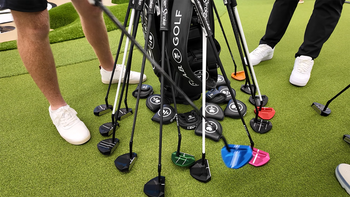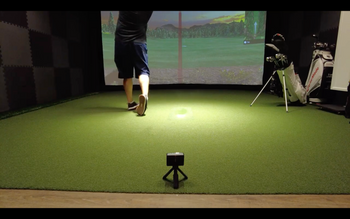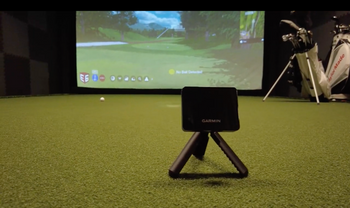You're thinking about setting up the FlightScope Mevo+ in your home simulator? Let me tell you what I've learned after testing this thing indoors for months.
First off, you'll want to grab a tape measure before getting too excited. This launch monitor uses Doppler radar technology, which means it needs serious room to work its magic. You're looking at potentially 21 feet of depth - yeah, that's a lot of real estate in most homes.
Here's the deal: The Mevo+ tracks your ball using radar waves, so it needs space behind you and in front of you to capture all that data. Think of it like this - the radar needs to "see" your club through impact and follow the ball's initial flight. That's why camera-based systems might work better if you're cramped for space, since they capture everything from above or the side.
But don't write off radar just yet. If you've got the room, this unit delivers crazy accurate numbers. We're talking ball speed, launch angle, spin rates - all the nerdy stuff that actually helps you understand why your 7-iron keeps ballooning on you. The accuracy rivals units costing three times as much.
What really sets this apart is how it plays nicely with different simulator software. Whether you're into E6 Connect or GSPro, the Mevo+ connects seamlessly. That flexibility means you're not locked into one ecosystem - huge win if you like options.
Now, about that space issue. Sometimes you can get away with less than 21 feet if you're creative with placement and settings. But radar systems really shine when you give them room to breathe. If your garage or basement can handle it, you'll get tour-level data that'll transform how you practice.
Bottom line? The Mevo+ is killer for indoor sim setups if you've got the space. Just measure twice before you buy once.
Key Features
Optimal Device Placement: The Mevo+ launch monitor must be positioned 7–9 feet behind the golf ball for accurate tracking, utilizing its radar-based technology.
Minimum Ball Flight Distance: A minimum of 8 feet is required between the golf ball and the impact screen or net for reliable data, with 13 feet recommended for best results.
Recommended Room Dimensions: For a comfortable and accurate setup, a room should ideally be at least 10 feet wide, 21 feet deep, and 9–10 feet tall, though you can function with as little as 16 feet in total length if needed.
Short Indoor Mode for Small Spaces: If room depth is limited, the Mevo+ offers a Short Indoor Mode that works with as little as 14–16 feet of total length and 6 feet of ball flight, though with slightly reduced spin accuracy.
Ceiling Height and Width Considerations: The room must allow for a full swing with the longest club, so ceiling height and width are important—especially for taller golfers or those with longer swings.
FlightScope Mevo+ Launch Monitor
Mevo+ packs tour-quality launch monitor performance into a portable powerhouse.
Finding the Perfect Room Size for Your FlightScope Mevo Plus Golf Simulator
You're gonna need some serious space if you want to set up a FlightScope Mevo+ in your garage or basement. This thing uses something called Fusion Tracking - basically a combo of radar and a camera working together to track your shots.
Here's the catch: you can't just plop it down anywhere. The Mevo+ needs to sit a full 8 feet behind where you're teeing up. Yeah, that's right - 8 feet back just to get started.
Now think about this - you also need room for the ball to actually fly after you hit it. The radar needs to track that ball for at least 8 feet past impact to give you accurate numbers. Even better if you can give it 13 feet of flight.
Do the math, and you're looking at needing a space that's at least 16 feet deep, though 21 feet is what you really want. Width-wise, you'll need about 10 feet so you don't clip the walls on your backswing. And unless you're planning to choke down on every club, figure on 9-foot ceilings minimum.
The Fusion Tracking system is pretty slick - the radar catches your ball speed and spin while the camera helps nail down the launch angle and direction. But all that tech means it needs room to work properly. Cram it into a tight space, and your numbers won't be worth much.
If you're over 6 feet tall or have a longer swing, you might need even more clearance up top. Nothing ruins a practice session faster than punching a hole in your ceiling with a driver.
Here's the real question, though - is all that space requirement worth it? Or should you look at one of those camera-based launch monitors that don't need as much room? That's something you'll have to figure out based on your setup.
Radar or Camera Launch Monitors – Which Is Ideal for Your Indoor Golf Studio?
You know how some launch monitors need you to set up like 20 feet from your hitting screen? That's where photometric units like the SkyTrak+, Bushnell Launch Pro, and Foresight GC3 really shine. Since they park right beside your ball instead of way back behind you, you're not eating up all that precious garage or basement space.
Here's the kicker - these camera-based bad boys don't need tons of room to track your ball flight either. So if you're squeezing a simulator into a tight spot, something like the SkyTrak+ lets you stand way closer to your impact screen compared to radar units like the Mevo Plus. We're talking serious square footage savings here.
But hold up - radar monitors like the FlightScope have their own party trick. Picture this: you're hosting simulator night with your regular foursome, and half of 'em swing from the wrong side of the ball (yeah, I'm looking at you, lefties). With those side-mounted photometric monitors, you're constantly shuffling the unit from one side to the other every time you switch between righties and lefties. Total buzzkill for keeping the round moving.
The FlightScope Mevo+ just sits there behind you, tracking shots from both sides without breaking a sweat. No more musical chairs with your launch monitor while your buddy's waiting to hit.
Here's the deal - if you're cramming a sim into your spare bedroom, those photometric monitors are probably your ticket. But if you've got a crew that swings from both sides and enough room to work with? The Mevo+ keeps everyone in rhythm without the constant equipment shuffle. Just depends on what matters more for your setup.
FlightScope Mevo+ Launch Monitor
Mevo+ packs tour-quality launch monitor performance into a portable powerhouse.
Is the FlightScope Mevo+ Launch Monitor Worth It?
Absolutely, while the FlightScope Mevo+ Launch Monitor is a great product, there are a few pros and cons that you need to be aware of:
Pros:
-
Exceptional Data Accuracy with Proper Space: When you have adequate room dimensions (21 feet deep ideally), the Mevo Plus delivers tour-level accuracy with ball speed readings within 1% of high-end systems like Trackman, making it incredibly reliable for serious practice and game improvement.
-
The device offers both Standard Indoor Mode and Short Indoor Mode, allowing you to adapt to different space constraints. Even in tighter spaces with just 15-16 feet of room length, you can still get functional data for practice sessions.
-
Outstanding Value for Professional-Grade Features: At its price point, the Mevo Plus provides over 20 data parameters (expandable to 50+ with upgrades), including advanced metrics like face impact location and D-plane data that were previously only available on much more expensive systems.
Cons:
-
The device demands substantial room dimensions with a recommended 21 feet of depth, 10 feet of width, and 9-10 feet of ceiling height, which may eliminate many basements, garages, or smaller rooms from consideration for optimal performance.
-
Reduced Accuracy in Compact Spaces: When forced to use Short Indoor Mode due to space constraints, you'll experience slightly reduced spin accuracy and data quality compared to the full setup, potentially compromising the precision you're paying for.
-
Indoor Setup Complexity: Unlike camera-based systems, the Mevo Plus requires metallic dots on golf balls for accurate indoor spin readings, precise 7-9 foot placement behind the hitting area, and careful alignment procedures that can be time-consuming to perfect.
Frequently Asked Questions
What are the minimum room dimensions required for a FlightScope Mevo Plus indoor golf simulator?
For optimal performance, the recommended indoor room dimensions are at least 10 feet wide, 21 feet deep, and 9 feet tall. In some cases, you can get by with a minimum of 16 feet in depth, but 21 feet is ideal for the most accurate tracking.
How should I position the FlightScope Mevo Plus within my simulator space?
The Mevo Plus should be set up 7–9 feet behind the golf ball. You also need a minimum of 8 feet (ideally 13 feet) between the golf ball and your impact screen or net for the device to accurately track ball flight.
What happens if my room is smaller than the recommended dimensions?
If your space is too small, you may experience missed shots, incorrect spin and launch data, and inconsistent readings. The device may struggle to track ball flight accurately, especially if you don’t have enough depth for the ball to travel.
Is there a way to use Mevo Plus in smaller rooms?
Yes, the Mevo Plus offers a Short Indoor Mode, which requires at least 14–16 feet of room length and a minimum of 6 feet of ball flight. However, this mode may result in slightly reduced spin accuracy and requires the use of metallic dots on the balls.
What ceiling height is necessary for safe and effective use?
A ceiling height of at least 9–10 feet is recommended to accommodate a full golf swing with any club, especially for taller golfers or those with a long swing arc.
Conclusion
You know that feeling when you're hitting balls at the range and have no clue if your 7-iron actually went 150 or 170? The FlightScope Mevo+ solves that problem and then some. At under three grand, it's basically like having your own personal TrackMan without selling your car.
This thing tracks everything. We're talking ball speed, how fast your club's moving, your launch angle - all the numbers that matter. It'll tell you exactly how far you carried it versus total distance, which is huge when you're trying to dial in your yardages. Plus, it shows you spin rates, which explains why your buddy's ball stops on a dime while yours rolls off the back.
Want to get really nerdy? Upgrade to the Pro Package and you'll see stuff like face-to-path (that's how open or closed your clubface is relative to your swing direction) and attack angle. It's like having a tour-level coach watching every swing. You'll finally understand why you're hitting those weak fades instead of the draw you've been trying to work on.
Here's where it gets fun - hook this bad boy up to your home simulator setup. It works with all the good software like E6 Connect, GSPro, and The Golf Club 2019. The standard package gives you 10 courses on E6, but spring for the Limited Edition and you're teeing it up at Pebble, St Andrews, and Bethpage Black. Nothing beats playing Augusta in your garage while it's snowing outside.
The accuracy is what sets this apart from cheaper options. Your shots fly the same way they would on the course - same shape, same distance, same everything. That pull-hook you hit with your driver? Yeah, it's gonna show up indoors too. But that's the point. You can actually practice fixing your misses instead of just mindlessly hitting balls.
Now here's the catch - you need space. Lots of it. We're talking decent room depth because this unit sits behind you and needs to track the full ball flight. If your ceiling's only 8 feet high or you've got a shallow hitting area, you might run into issues.
One feature that's clutch? It handles both righties and lefties without any fuss. Just move it to the other side and you're good to go. Perfect for when your southpaw buddy comes over and wants to join the fun. No recalibration, no complicated setup changes.
The numbers you get are tour-quality accurate. The spin axis tells you exactly why that ball curved 30 yards right. Club path data shows if you're coming over the top (spoiler: you probably are). And smash factor? That's basically how efficiently you're transferring energy to the ball. Most amateurs hit around 1.3 with their driver - tour pros are closer to 1.5.
Setting it up takes maybe 15 minutes. Download the app, connect via WiFi, and start swinging. The interface is clean and easy to read, even after a few beers. You can save all your sessions to track improvement over time, which is motivating when you see your distances getting more consistent.
Is it perfect? Nah. Like any radar-based monitor, it can occasionally miss a shot or give you a wonky reading, especially with specialty shots like flop shots or punch shots. And obviously, it's not reading actual ball flight like those $20,000 camera systems.
But for improving your game? This thing's money. You'll know your exact carry distances, understand why you're missing left or right, and have endless entertainment for those days when the course is closed. The data helps you practice with purpose instead of just beating balls.
Bottom line - if you're serious about getting better and have the space for it, the Mevo+ delivers way more value than its price tag suggests. It's the difference between guessing what went wrong and knowing exactly what to fix.






